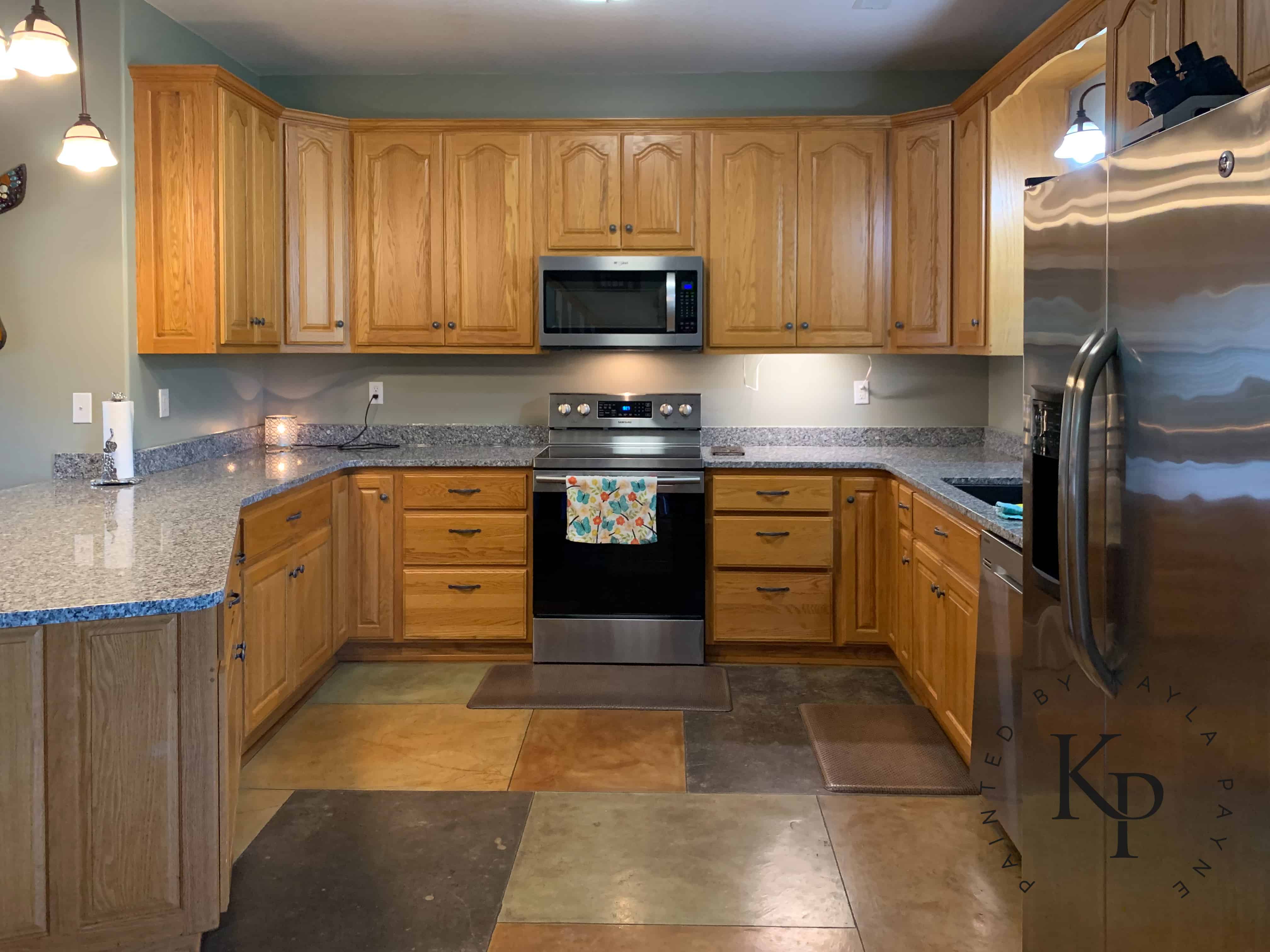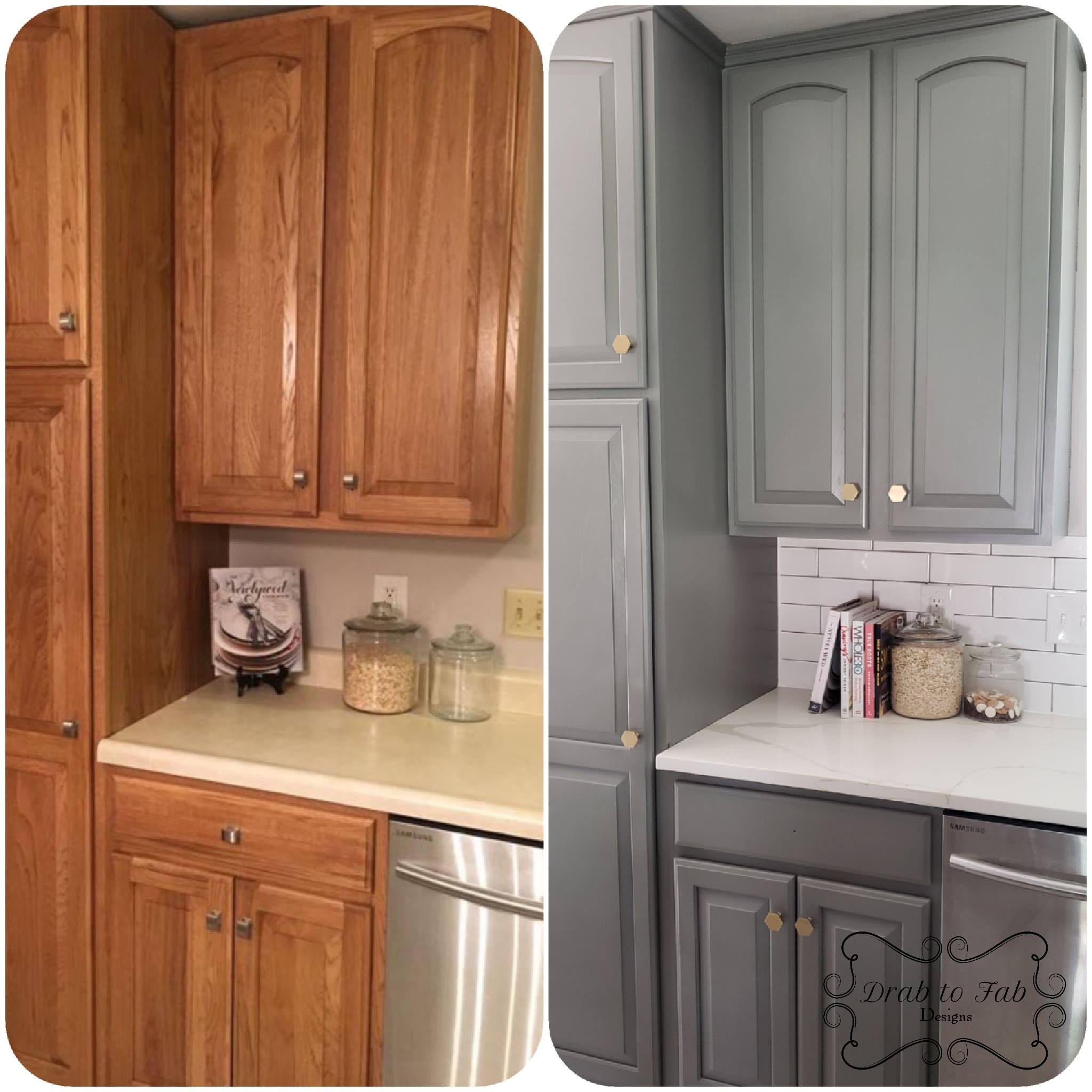Pre-Painting Preparation for Oak Cabinets: Painting Oak Cabinets Gray

Transforming oak cabinets into sleek gray masterpieces requires meticulous preparation. The success of your paint job hinges on proper sanding, cleaning, and filling, ensuring a flawlessly smooth surface for optimal paint adhesion and a professional finish that will stand the test of time. Overlooking these steps can lead to an uneven paint application, chipping, and a less-than-desirable final result.
Sanding Oak Cabinets, Painting oak cabinets gray
Sanding is crucial for creating a surface receptive to paint. Oak’s natural grain and hardness demand a systematic approach using different grits of sandpaper to achieve the desired smoothness. A rushed sanding process will result in a visibly uneven finish, making the paint job look amateurish. The grit progression is essential; each step prepares the surface for the next, progressively refining the wood and removing imperfections.
| Sanding Method | Pros | Cons | Grit Progression |
|---|---|---|---|
| Hand Sanding | Greater control, less risk of damage, suitable for intricate details. | Labor-intensive, time-consuming, can cause fatigue. | Start with 120-grit, progress to 180-grit, then 220-grit for a final smoothing. |
| Power Sanding (Random Orbital Sander) | Faster, more efficient, removes material quickly. | Requires skill to avoid sanding too aggressively, potential for damage if not used carefully. | Start with 120-grit, progress to 180-grit, then 220-grit for a final smoothing. Use a finer grit (320) if needed for extremely smooth surfaces. |
Cleaning and Priming Cabinet Surfaces
After sanding, thoroughly clean the cabinets to remove dust and debris. A tack cloth is excellent for this purpose. For stubborn grime, a mild detergent solution can be used, followed by rinsing with clean water and allowing it to dry completely. This ensures the primer adheres properly. The primer acts as a bonding agent between the wood and the paint, preventing the gray paint from being absorbed unevenly into the wood’s grain and enhancing the final color’s vibrancy. For oak cabinets, a high-quality oil-based primer is recommended for superior adhesion and blocking of tannins in the wood that could bleed through the paint. This is particularly important for achieving a consistent gray color.
Filling Imperfections
Before priming, fill any imperfections like nail holes, cracks, or scratches with a high-quality wood filler. Choose a filler that matches the oak’s color as closely as possible to minimize visibility after sanding. Apply the filler sparingly, following the manufacturer’s instructions. Allow it to dry completely before sanding it smooth with fine-grit sandpaper (220-grit or higher). This step ensures a seamless and professional-looking finish, eliminating any unevenness that could show through the paint. For smaller imperfections, such as nail holes, a small amount of filler is sufficient, applying it slightly above the surface and sanding it flush. Larger cracks may require multiple applications, allowing each layer to dry completely before the next.
Choosing and Applying Gray Paint to Oak Cabinets

Transforming oak cabinets with a fresh coat of gray paint is a rewarding project, capable of dramatically altering the feel of a kitchen or bathroom. The right paint and application technique are key to achieving a professional, long-lasting finish. This section details the process, from selecting the appropriate paint to achieving a flawlessly smooth surface.
Gray Paint Types for Cabinets: A Comparison
The choice of paint significantly impacts the final result. Different paint types offer unique advantages and disadvantages, making careful consideration crucial. The following comparison highlights the key differences between popular options for cabinet painting.
- Latex Paint: Latex paints are water-based, making them easy to clean up with soap and water. They offer good breathability, preventing moisture buildup under the paint film. However, they may require more coats for full opacity on dark wood like oak, and the drying time can be slightly longer than oil-based paints. They are generally less durable than oil-based paints but are a more environmentally friendly option.
- Oil-Based Paint: Oil-based paints offer superior durability and a harder, more resistant finish. They tend to level out better, resulting in fewer brushstrokes. However, they require mineral spirits for cleanup, have a strong odor, and take significantly longer to dry. Their high durability makes them suitable for high-traffic areas, but the environmental impact is higher compared to latex paints.
- Chalk Paint: Chalk paint is known for its matte finish and ease of application. It adheres well to various surfaces, including wood, and often requires less preparation than other paints. However, it’s less durable than latex or oil-based paints and requires a sealant for protection and longevity. Its unique texture lends itself to a more rustic, distressed look.
Step-by-Step Gray Paint Application
Achieving a professional-looking finish involves meticulous attention to detail. Following these steps will help ensure even coverage and minimize brushstrokes.
- First Coat Application: Apply a thin, even coat of paint using a high-quality brush or roller. Work in the direction of the wood grain for a smoother finish. Avoid overloading the brush; this can lead to drips and uneven coverage. Allow the paint to dry completely according to the manufacturer’s instructions.
- Sanding (if necessary): Once the first coat is dry, lightly sand any imperfections with fine-grit sandpaper. This helps to create a smoother surface for the subsequent coats and improves adhesion. Wipe away sanding dust with a tack cloth.
- Subsequent Coats: Apply additional coats, following the same process as the first coat. Allow each coat to dry completely before applying the next. The number of coats needed will depend on the paint type and the desired opacity. Two to three coats are usually sufficient for good coverage on oak cabinets.
- Final Inspection and Touch-ups: After the final coat is dry, carefully inspect the cabinets for any imperfections. Use a small brush to touch up any areas that need additional paint. Allow the paint to cure completely before using the cabinets.
Sample Gray Color Palette for Oak Cabinets
The choice of gray shade significantly impacts the overall aesthetic. Different grays interact differently with light, creating diverse moods.
- Soft Dove Gray: A light, airy gray with subtle blue undertones. This shade creates a calming, tranquil atmosphere, particularly effective in rooms with ample natural light. In low light, it appears slightly muted, maintaining a sense of serenity.
- Warm Gray: A gray with subtle brown or beige undertones. This shade offers a more neutral and inviting feel, working well in both modern and traditional settings. It tends to remain relatively consistent across different lighting conditions, making it a versatile choice.
- Charcoal Gray: A deep, dramatic gray that adds sophistication and elegance. This shade creates a bold statement, particularly effective in rooms with bright lighting where the depth of the color is enhanced. In low light, it can appear almost black, adding a sense of mystery.
Post-Painting Finishing Touches and Maintenance

Transforming oak cabinets with a fresh coat of gray paint is a rewarding undertaking, but the true beauty of the project lies in the longevity and enduring appeal of the finish. Protecting your newly painted cabinets requires careful consideration of the right sealant and a consistent maintenance plan. The choices you make at this stage will significantly impact the appearance and lifespan of your cabinets for years to come.
Protecting the painted finish is crucial for resilience against everyday wear and tear. Several options exist, each offering unique advantages and disadvantages depending on the level of protection required and the environment. Choosing the right sealant is paramount for achieving a durable and attractive finish.
Sealant Options for Painted Cabinets
The selection of a sealant depends largely on the desired level of protection and the cabinet’s location. High-traffic areas, like kitchens, demand a more robust sealant than less-used areas. Consider these options:
- Polyurethane: A popular choice, polyurethane offers excellent durability and protection against scratches and moisture. It’s available in various sheens, from satin to high-gloss, allowing for customization to match the overall aesthetic. Its resistance to abrasion makes it ideal for high-traffic kitchens and bathrooms. A potential drawback is the strong odor during application, requiring good ventilation.
- Acrylic Sealant: Acrylic sealants provide a good balance between durability and ease of application. They are water-based, making them low-odor and relatively easy to clean up. While not as durable as polyurethane, they offer sufficient protection for cabinets in less demanding areas. They are generally less expensive than polyurethane options.
- Wax: Wax provides a softer, more subtle protective layer. It’s easy to apply and offers some protection against minor scratches and moisture, but it’s not as durable as polyurethane or acrylic sealants. Wax is best suited for cabinets in areas with less traffic and where a more natural, less glossy finish is desired. Regular reapplication is necessary to maintain protection.
Maintaining Gray Painted Oak Cabinets
Consistent maintenance is key to preserving the beauty and integrity of your newly painted cabinets. A proactive approach will significantly extend their lifespan and prevent costly repairs.
Painting oak cabinets gray – The following tips will help maintain the gray painted finish on your oak cabinets:
- Regular Cleaning: Wipe down cabinet surfaces weekly with a soft, damp cloth. Avoid harsh chemicals or abrasive cleaners, as these can damage the paint. For tougher stains, use a mild dish soap solution and rinse thoroughly with clean water.
- Preventative Measures: Use coasters under glasses and other beverages to avoid water rings. Keep sharp objects away from the cabinet surfaces to prevent scratches. Use pot holders or trivets to protect the cabinets from hot pans and dishes.
- Address Damage Promptly: Minor scratches or chips can often be repaired with touch-up paint. Larger damage may require professional repair or repainting.
- Avoid Excessive Moisture: Ensure proper ventilation in the kitchen and bathroom to prevent excessive moisture buildup, which can damage the paint. Wipe up spills immediately.
- Reapply Sealant: Depending on the type of sealant used, periodic reapplication may be necessary to maintain optimal protection. Consult the sealant manufacturer’s instructions for recommended reapplication intervals.
